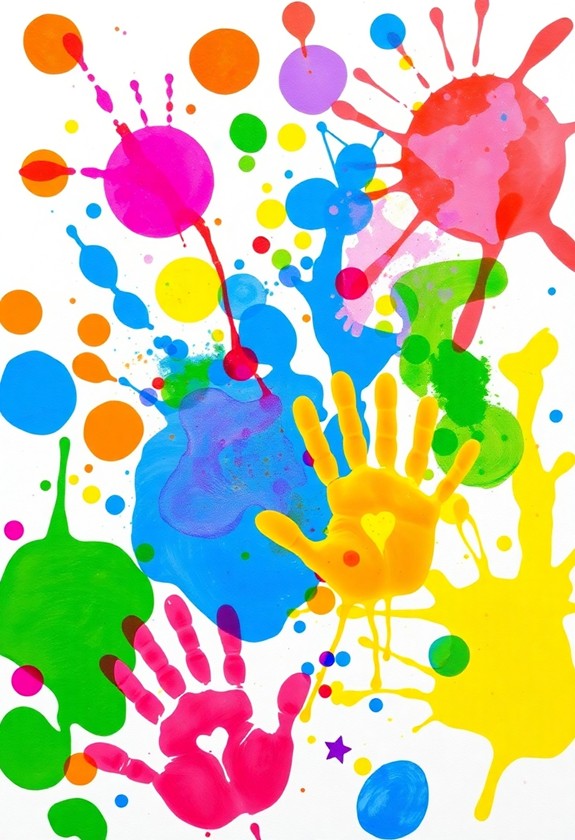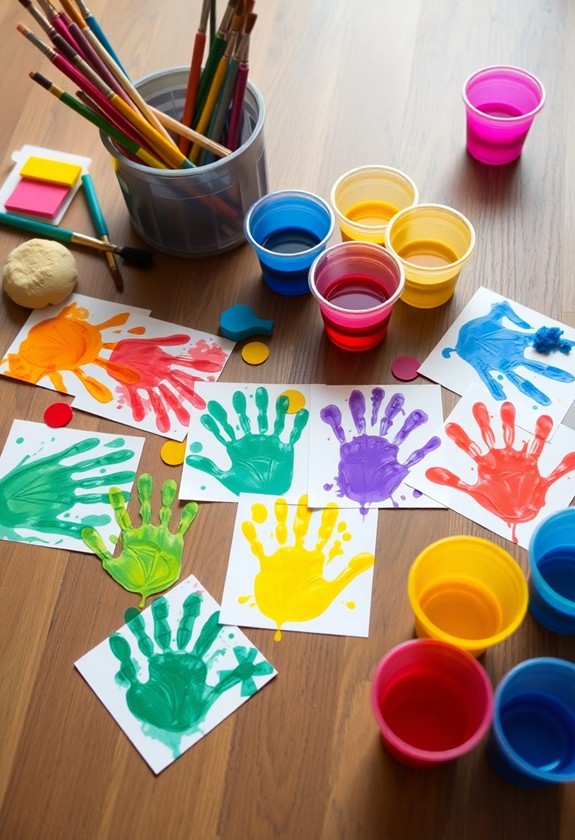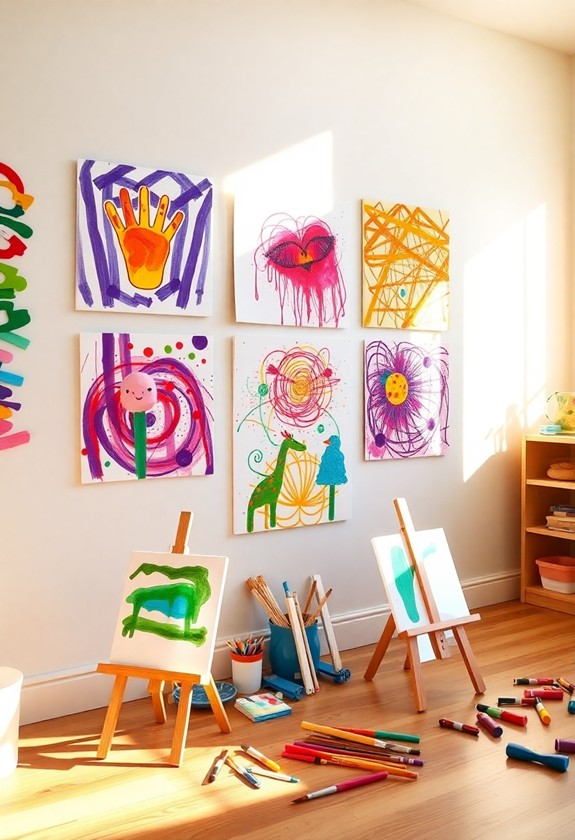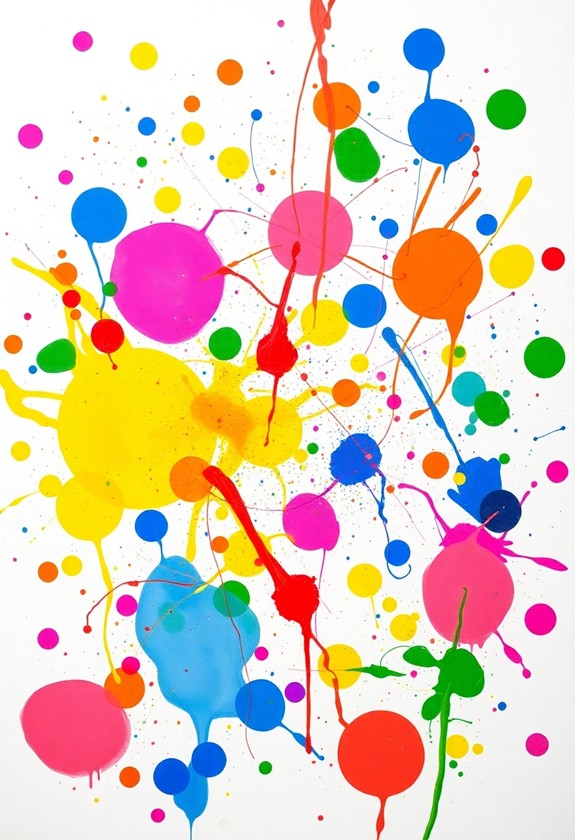Toddler painting isn't just messy fun – it's a cognitive powerhouse! Your little one's brain is buzzing with activity as they investigate colors, enhancing recognition and discrimination skills. They're likewise fine-tuning those motor skills, prepping for future writing escapades. Sensory play? Check! Problem-solving through color mixing? You bet! Painting lets kiddos express emotions, boosting emotional intelligence. It's a language booster too, encouraging descriptive chatter. Plus, it sharpens spatial awareness and stretches attention spans. Who knew a paintbrush could pack such a developmental punch? But wait, there's even more to uncover about this colorful cognitive expedition!
Creative Highlights
- Painting enhances color recognition, teaching primary and secondary colors and fostering emotional intelligence through color associations.
- Fine motor skills improve through brush manipulation, enhancing hand-eye coordination and future writing abilities.
- Sensory exploration during painting activities promotes sensory integration and neural pathway development.
- Problem-solving skills develop as toddlers experiment with color mixing and plan their artistic creations.
- Emotional expression and regulation are cultivated, providing a safe space for self-expression and boosting self-esteem.
Color Recognition and Discrimination
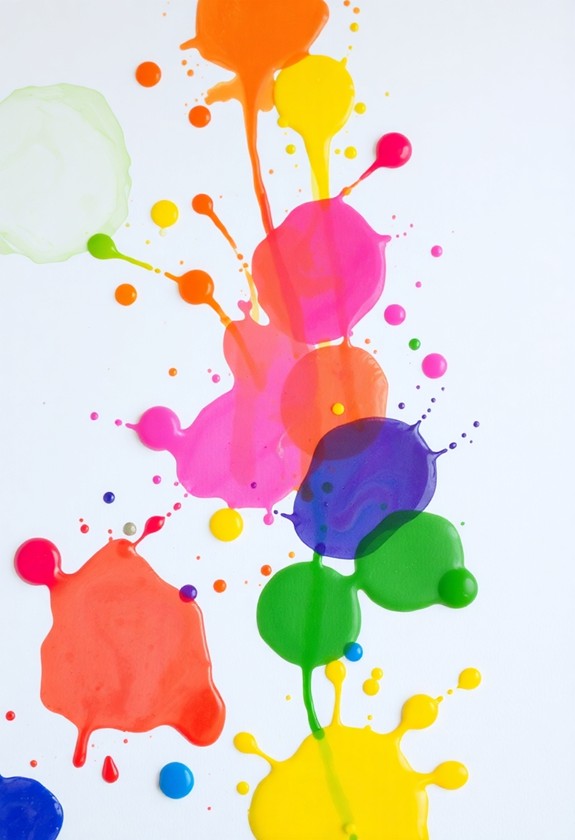
Many toddlers begin recognizing and discriminating colors between 18 months and 3 years old. Painting is a fantastic way to improve this skill! As your little one experiments with different hues, they're learning to:
- Identify primary colors
- Mix colors to create new shades
- Recognize color patterns
But wait, there's more! Painting helps toddlers develop their color vocabulary too. They'll soon be shouting, "Look, Mommy! I made purple!" It's like a color party in their brain! Triangle-shaped crayons and markers can refine your toddler's grip, further aiding in their artistic development and color recognition skills.
To make the most of this colorful adventure:
- Provide a variety of paint colors
- Talk about the colors as they paint
- Play fun color-matching games
Fine Motor Skill Development
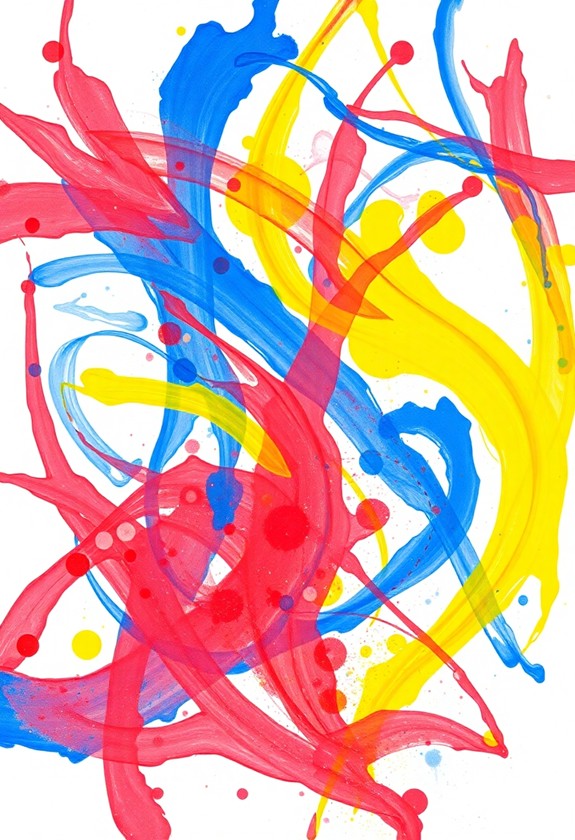
As color exploration is a feast for the eyes, painting in addition serves as a playground for your toddler's hands. It's a fantastic way to develop those all-important fine motor skills! Watch in awe as your little one grips brushes, squeezes bottles, and makes sweeping arm movements. They're not just creating art, they're building hand strength and dexterity! Triangular marker shapes can promote proper grip, aiding early writing techniques as well as allowing for creative expression. Non-toxic, washable formulas guarantee easy cleanup, reducing stress for parents during these messy yet essential developmental activities.
Here's what painting does for your tot's motor skills:
- Improves hand-eye coordination
- Boosts finger and wrist control
- Enhances grip strength
But wait, there's more! Painting similarly helps with:
- Pencil control (hello, future writing skills!)
- Scissor use (snip, snip!)
- Self-care tasks (like buttoning clothes)
Sensory Exploration and Integration
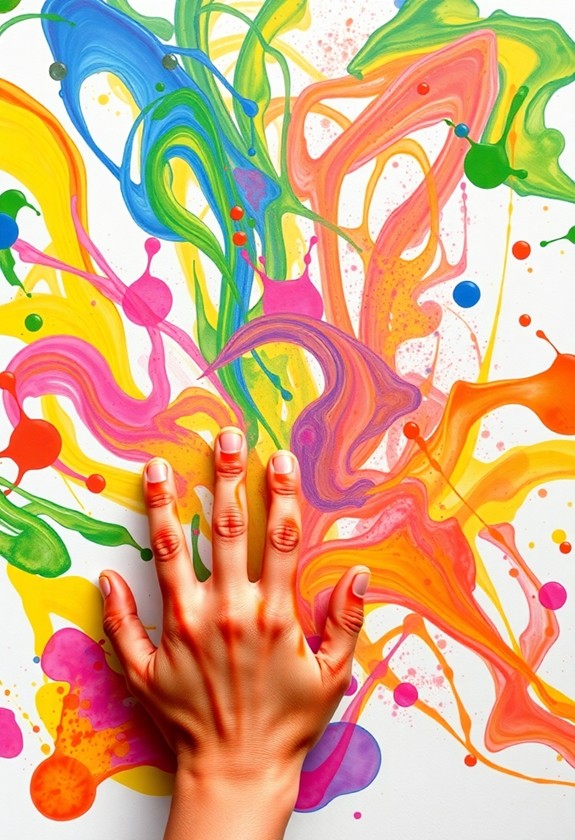
Sensory stimulation bursts into life when your toddler dips their hands into paint. It's a feast for the senses! Your little one feels the cool, squishy texture, sees lively colors swirl, and maybe even catches a whiff of that distinct paint smell. This multi-sensory experience is like a workout for their brain! Sensory Processing Disorders can particularly benefit from these engaging activities, as they encourage sensory integration and help reduce anxiety.
As they squish, smear, and splatter, your toddler's senses are working overtime to process all the input. It's sensory integration in action! Their brain is learning to:
- Combine different sensory signals
- Filter out unnecessary information
- Respond appropriately to stimuli
And it's not just fun – it's essential for development! This sensory play helps build neural pathways, enhancing your child's ability to interpret and interact with their world. So, let's get messy and paint the town red… and blue, and green, and yellow!
Problem-Solving Through Experimentation
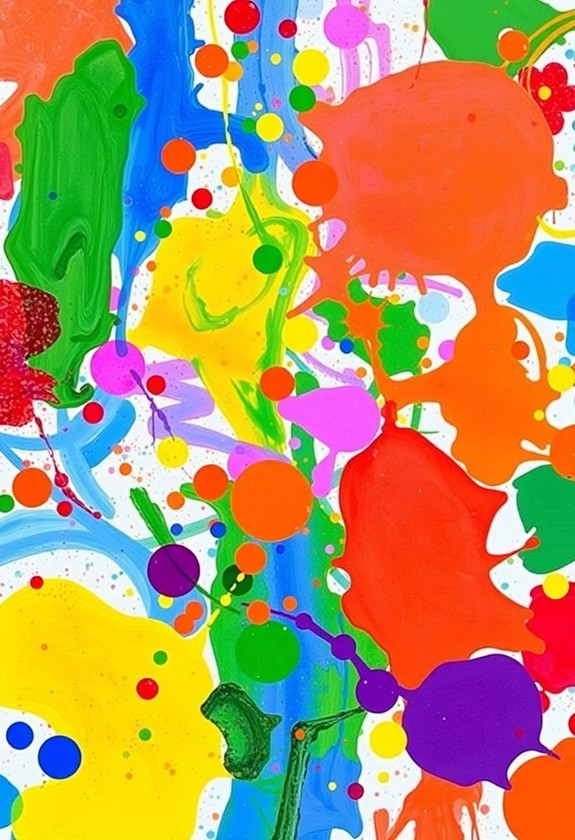
Beyond sensory exploration, toddler painting opens up a world of problem-solving opportunities. Watch as your little one uncovers the magic of mixing colors! They'll experiment with different brush strokes, figuring out how to create new shapes and textures. It's like a mini science lab right on their canvas! This creative process fosters cognitive development and improves their fine motor skills, setting the stage for future learning experiences.
You'll see their wheels turning as they tackle challenges:
- How can I make green?
- What happens if I use too much water?
- How do I fill in this big space?
Each painting session is a chance for your toddler to think critically and find creative solutions. They're learning cause and effect, spatial awareness, and decision-making skills. And the best part? It's all wrapped up in a fun, messy package! So grab those brushes and let the problem-solving party begin!
Emotional Expression and Regulation
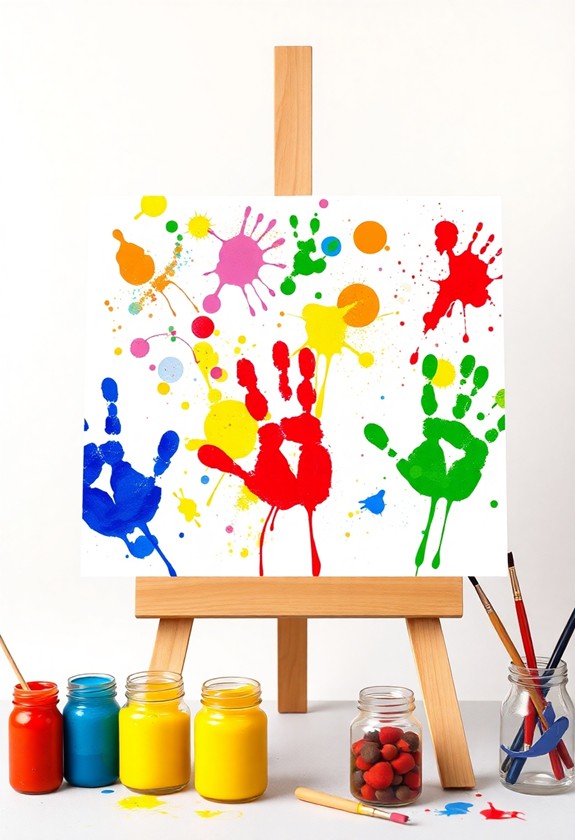
Through painting, toddlers uncover a powerful outlet for emotional expression and regulation. It's amazing to watch! As your little one swirls colors and creates masterpieces, they're actually learning to manage their feelings. Wow! Painting likewise fosters creative expression and imagination, allowing children to investigate their inner world through colors and shapes. This creative process can be particularly beneficial when using non-toxic materials that are safe for young artists.
Here's how painting helps:
- It's a safe space to express big emotions
- Colors can reflect moods (blue for sad, yellow for happy)
- The act of painting itself can be calming
You'll notice your toddler becoming more emotionally aware as they paint. They might even start talking about their feelings! And get this: painting can boost their self-esteem too. When they finish a piece, they'll feel proud and accomplished. It's a win-win situation!
Language and Communication Enhancement
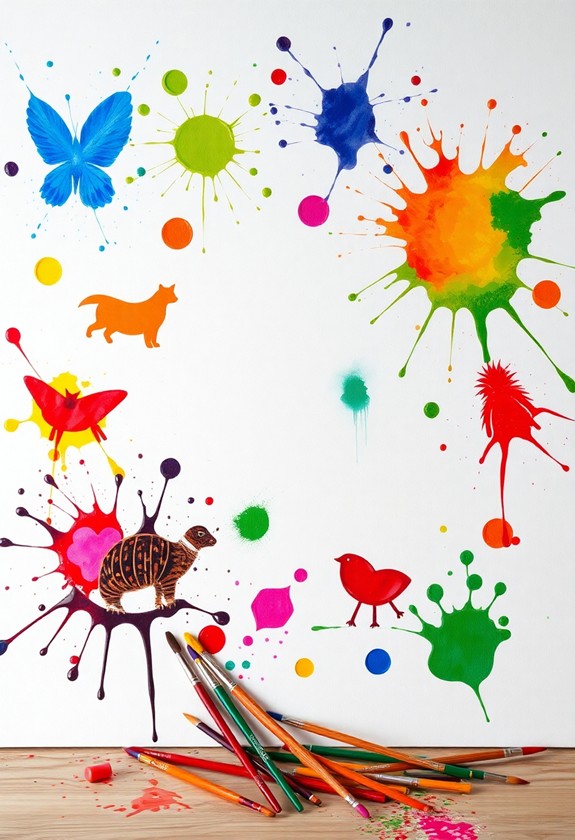
Painting activities offer more than just emotional benefits for toddlers. They're also fantastic for boosting language and communication skills! As your little one paints, they're learning new words and concepts. You'll hear them chattering away, describing colors, shapes, and their creations. It's a vocabulary explosion!
Here's how painting improves language skills:
- Encourages descriptive language use
- Prompts conversations about art and ideas
- Builds confidence in self-expression
But wait, there's more! Painting time is perfect for asking questions and engaging in dialogue. "What are you making?" "Tell me about your picture!" These interactions are golden opportunities for language development. And don't forget to praise their efforts – it'll make them even more enthusiastic to talk about their masterpieces. So grab those brushes and get ready for a chatter-filled, colorful adventure!
Spatial Awareness and Orientation
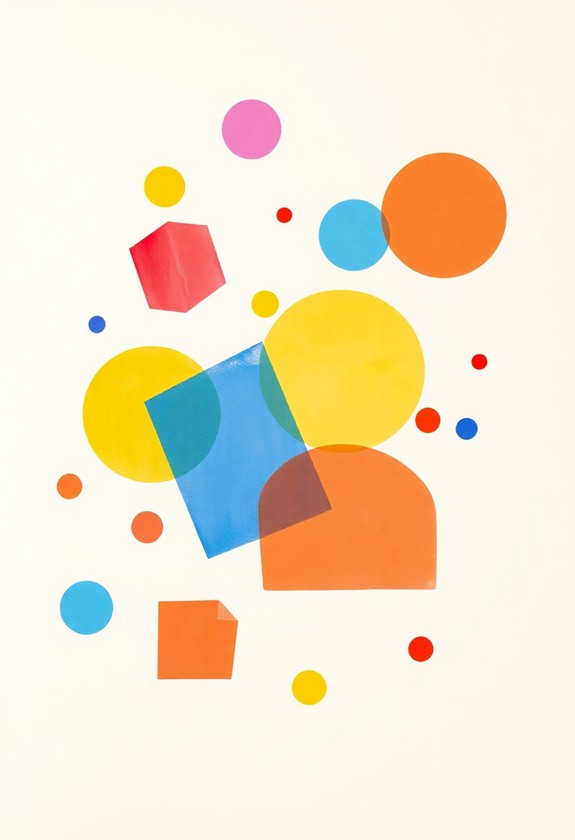
In addition to language benefits, toddler painting activities greatly boost spatial awareness and orientation skills. When your little one paints, they're investigating the world of shapes, sizes, and positions! They'll learn to place objects on paper, understanding concepts like "above," "below," and "next to." It's like a fun geography lesson for tiny hands!
Watch as your toddler uncovers:
- How to fill spaces on paper
- The relationship between objects
- Concepts of distance and direction
These skills are essential for future learning, from math to reading. Plus, it's a blast! Your child will become a mini-Picasso, creating masterpieces during the process of developing their spatial superpowers. So, grab those brushes and let the artistic journey begin! You'll be amazed at how quickly your little one's spatial skills will grow, painting their way to cognitive success!
Memory and Attention Span
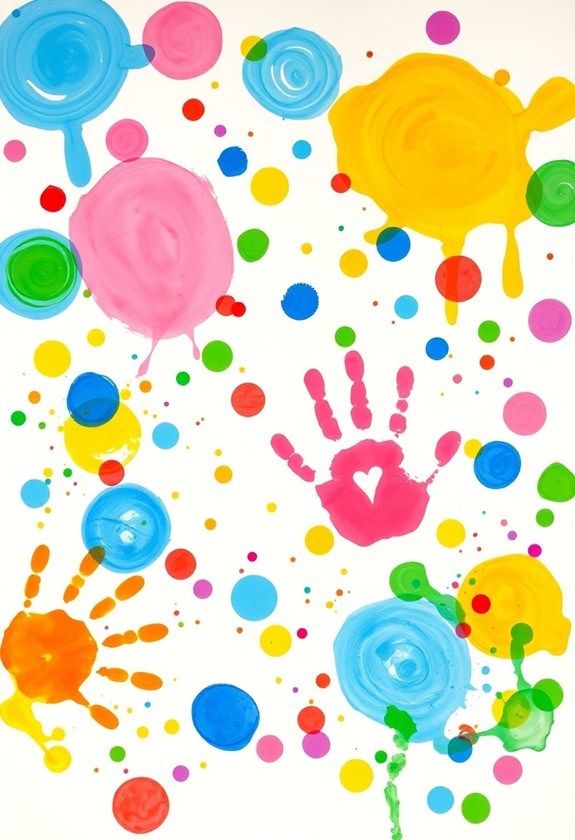
Concentration blossoms as toddlers engage in painting activities. You'll be amazed at how your little one's memory and attention span grow through this colorful process! As they mix paints, create patterns, and experiment with textures, their minds are hard at work. They're learning to focus for longer periods and remember important details.
Here's how painting boosts memory and attention:
- Recalling colors and shapes they've used before
- Remembering step-by-step processes for creating art
- Focusing on completing a painting from start to finish
But wait, there's more! Your toddler's brain is like a sponge, soaking up every drop of knowledge. They'll start to recognize their own artwork and even remember which colors they used last time. It's like magic! So grab those brushes and get ready for a mind-expanding adventure in creativity!
Curious Little Questions
What Age Is Best to Introduce Toddlers to Painting Activities?
Ready, set, paint! You can introduce your little Picasso to painting activities as early as 18 months old. But don't worry if you haven't started yet – it's never too late! Between 2 and 3 years is ideal, as toddlers are more coordinated and curious. Start with finger painting and gradually introduce brushes. Remember, it's all about fun and exploration, not masterpieces. Watch their eyes light up as they uncover the magical world of colors and textures!
Are There Non-Toxic Paint Alternatives Safe for Toddlers Who Still Mouth Objects?
You've got plenty of safe options for your little Picasso! Try these non-toxic alternatives:
- Homemade finger paints using cornstarch and food coloring
- Yogurt mixed with food coloring
- Pudding paints (yum!)
- Washable tempera paints (check labels for safety)
- Vegetable-based watercolors
These are all safe if accidentally ingested. Plus, they're easy to clean up! Remember, always supervise your toddler during painting activities. It's time to get messy and creative – let the colorful fun begin!
How Can Parents Encourage Reluctant Toddlers to Engage in Painting Activities?
Did you know that 85% of a child's brain develops by age 5? That's why it's essential to engage your toddler in painting! Here's how to encourage reluctant little artists:
- Make it fun! Turn painting into a game or storytelling activity.
- Lead by example – paint alongside them!
- Offer exciting tools like sponges, fingers, or toy cars to paint with.
- Praise their efforts, not just the result.
- Keep sessions short and sweet.
What Are the Best Surfaces for Toddler Painting Besides Paper?
You've got so many awesome options for toddler painting surfaces! Think outside the box and try:
- Cardboard boxes (flatten them for a huge canvas!)
- Sidewalks or driveways with washable chalk paint
- Plastic tablecloths or shower curtains
- Old bed sheets or pillowcases
- Bubble wrap for a fun, textured experience
- Aluminum foil for a shiny, crinkly surface
Don't forget to protect surfaces and clothes! These alternatives will have your little Picasso splashing color everywhere, sparking their creativity in no time!
How Often Should Toddlers Be Offered Painting Activities for Optimal Cognitive Benefits?
Envision this: your little one, brush in hand, ready to create a masterpiece! You might wonder, "How often should I let this budding Picasso loose?" Well, here's the scoop: offer painting activities 2-3 times a week for ideal cognitive benefits. But don't stress if it's not always possible! The key is consistency and fun. Mix it up with different tools and techniques. Remember, every stroke is a step towards learning. So, grab those paints and let the creativity flow!

